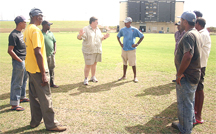By Marlon Munroe
Some life is expected from the normally flat and placid Guyana National Stadium playing surfaces and practice facilities for the International Cricket Council (ICC) World Cup Twenty20 in April after ICC Pitch Consultant Andy Atkinson adds his touch to it.

Atkinson will be conducting training seminars with local groundsmen to “pass on tips on how we are going to go about operations on preparing the playing areas”.
He said that while the surfaces are well kept they need a bit more grass.
“It is a bit technical since it is all about the fertiliser and the balance you need on the square, the amount of rolling you do for the pitches, the amount of watering and the time you need to prepare the pitches. Those will be some of the things we will be getting into over the next couple of days with slide shows on Monday and Tuesday,” Atkinson explained.
The Englishman’s job with the ICC is to oversee the preparation of the playing surfaces at all ICC events as well as inspect and assess proposed venues for ICC events and tournaments. Atkinson has worked with the ICC since 1999 and Melbourne Cricket Club at Lords from 1978-1980. He said that there is nothing wrong with the outfield at the Guyana National Stadium but the grass on the pitch is “thin and lacking in vigour.”
“We have done some soil tests over the years, for the last six months or so, and we have found that there is the basic problem with the fertiliser. The basic nutrients in the ground have been a bit too much used – one area for example is magnesium and we need to get that fixed up. In general, the square is recovering quite well because when I came here the last time it was quite bare.”
“There have also been football matches played here and I have replanted the square and there is only one other game before the World Cup and that is the regional match so that gives us basically three months to get the grass to recover since it has recovered well in six weeks after replanting it,” the pitch consultant said.
Apart from football contributing to the thinning of the grass at the venue, the 55-year-old Atkinson explained that a plethora of cricket matches will result in a slower recovery of the square. He said there needs to be more improvement on the area and this will be his focus, along with the cooperation of the stadium’s ground staff over the next few days.
“On the cricket pitch when you are rolling it for a lot of time it gets very hard and grass struggles to grow; it is the nature of cricket to get the pitch hard so the ball can bounce but one of the things we will be talking about is to adjust the techniques of preparation.
“We need to show the guys that you need not roll the cricket pitch for hours because all they will be doing is killing the grass and the pitch just gets flatter. Every pitch wants to have as much pace as possible and consistent bounce but I am not talking about balls coming over your head but bounce that will regulate from one spot since there is never going to (be) consistent bounce,” the former Wanderers curator elaborated.
He said the aim is to have the ball to bounce and carry through which would encourage the batsmen to play more shots and put more life into the games that will be played at the stadium.
Atkinson reported that some of the pitches in Australia are hard but there is grass growing on them. However, he said the difference between the two countries is what is done after matches to repair the pitches after a game would have been played.
He reasoned, “Once you would have played a match the grass is stressed out and it is dry for five days or ten days because you have not put water on it some days prior to the match. So when the match is over you put some water to revive it and then you want to open up the ground and put some nutrients down to fertilise to bring it up again.”
Stabroek Sport enquired about follow-up seminars and Atkinson replied that “in an ideal world there will be but you don’t know at this time what will happen.” However he said that he will be present during the World Cup and while it is not a regularly planned event he can visit Guyana again if it is arranged.
Meanwhile, the Guyana Cricket Board’s (GCB) Cricket Development Officer Reon King had previously disclosed that his committee plans to have a curator’s course for groundsmen in the country. He had noted that it is the Board’s way of tackling cricket holistically.





